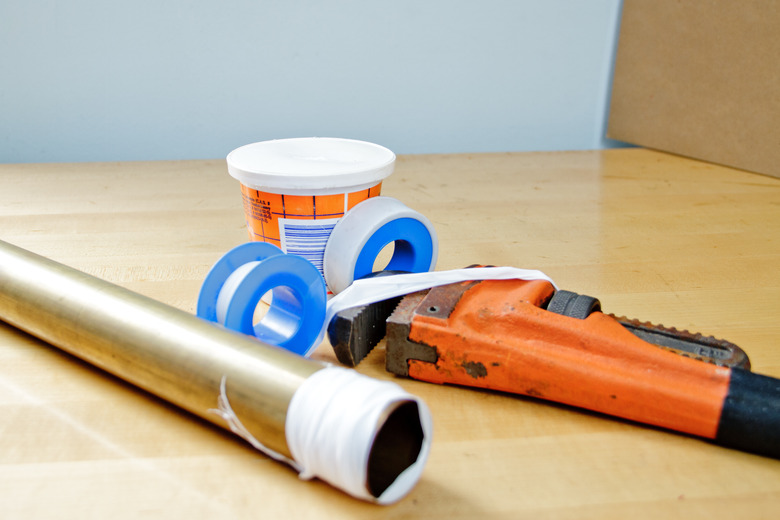Plumber's Putty Vs. Teflon Tape
We may receive a commission on purchases made from links.
While a single plumbing project might call for both plumber's putty and Teflon tape, you cannot substitute one for the other. Teflon tape, also called plumber's tape or thread-seal tape, gives a reliable seal on threaded pipe joints for liquids and gases that may be under considerable pressure. The plumber's putty acts as a flexible caulk in situations where you need water resistance—but it cannot withstand any significant pressure. Plumber's putty is not used on pipe threads, like Teflon tape is.
Teflon Tape Basics
Teflon Tape Basics
Teflon tape, also known as PTFE (polytetrafluoroethylene) tape, is a thin film that works as a sealant on threaded pipe joints. Different types and densities of PTFE tape are color-coded for different uses. White tape, which you will find in any hardware or DIY store, is suited for water supply pipes up to 3/8 inch in diameter. Yellow tape, which is twice as dense as white, is for use on gas lines. Red tape is for use on larger pipes—1/2 inch to 2 inches. There is also green tape for oxygen and medical gas lines, and copper, which acts a lubricant rather than as a sealant.
Using Teflon Tape
Using Teflon Tape
Begin at the end of the pipe with the male thread and wrap the tape around the thread the PTFE tape in a clockwise direction, overlapping the previous turn by about half, until you reach the end of the thread. The thin film will conform easily to the contours of the threads. Screw the other side of the joint down tight to get a complete, pressure-resistant seal.
Plumber’s Putty Basics
Plumber's Putty Basics
Different brands of plumber's putty have different ingredients. But they are all water-repellent, and they all remain soft and flexible for a long time. This makes them ideal for uses where a reversible water-resistant seal is required, but only where that seal will not be under pressure because the putty remains soft it would wash or blow out. Typical domestic plumbing applications for plumber's putty are as a sealant between the base of a faucet and the surface of a sink, and between the rim of a basket drain and a sink.
Using Plumber’s Putty
Using Plumber's Putty
In the case of a drain, run a generous bead of putty around the underside of the drain's rim, and then place it in the drain hole in the sink. Tighten down the drain from underneath according to the instructions, and then wipe off the excess putty with a damp rag. For a faucet, run a thick bead of putty around the base of the faucet before positioning it on the sink. Tighten down the faucet, and wipe off the excess putty.
Alternatives to Each
Alternatives to Each
You should never have to choose between Teflon tape and plumber's putty because they don't do the same job. But there are alternatives to Teflon tape and plumber's putty. Some plumbers prefer to use a liquid pipe compound (also called "pipe dope") instead of tape. And in some instances—such as on granite, where it can cause stains—plumber's putty is undesirable and silicone caulk is a better choice.
